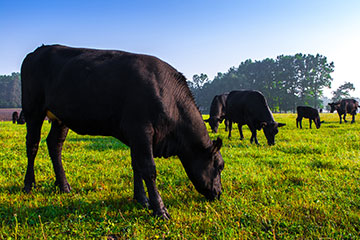Which beef cattle supplement best fits?
Apr 02, 2024

The first step in deciding what feed or feed type is best for your cattle is to verify which nutrients are limiting or preventing the utilization of forage energy. Grazing cattle make their choice of diet by selectively grazing the pasture they are housed on, which can be of unknown nutrient composition. It is well established that cattle have nutrient requirements that vary with weight, production level, environmental condition, and genetics. It is relatively easy to determine these nutrient requirements for a specific beef animal — as well as the makeup of the forages used to model feedstuffs that provide important components not found in the basal forage diet.
For the most part, energy is limited with our area's typical forage programs. However, supplementing energy to cattle consuming high-forage diets can reduce forage intake, digestibility, and subsequent performance. University of Florida research (Moore, et Al. 99) 2 suggests that supplementing beef cattle with as little as 2 lbs. of corn significantly reduced hay intake and fiber digestion which also altered the rumen microbial population. This can lead to a lack of proper protein availability, potentially affecting expected performance. Thanks to more targeted research, it’s fairly easy to calculate the specific ratio of net energy (NEg) to crude protein (CP) for maximal efficiency for beef cattle consuming high forage rations (Bowman, etal. 96)3.
Moderate CP supplements containing appreciable concentrations of NEg are available, but not all are formulated with the intent of maximum forage consumption. Many dry-milled mixed commodities often contain extreme concentrations of starches and non-structural carbohydrates (NSC) which directly affect fiber digestion, resulting in an expensive trading of energy supplementation. If forage quantities are suboptimal or if the feeding system is designed more toward finishing, these types of energy supplements can be balanced to produce the desired results. Selecting energy feeds that contain more concentrations of fiber, particularly soluble fiber, produces the synergistic approach to matching forage energy without interfering with digestion or consumption in forage-based rations similar to cow/calf or short-term stocker feed systems. These types of ingredients are routinely available in our area at affordable prices. Additionally, pelleted, fiber-based feeds can provide advantages over higher-energy commodities due to the pelleting process, making these fibrous ingredients more available to the animal. Subsequently, it is likely that the inclusion rate of these pelleted feeds can be lower than other poorly balanced mixes.
In summary, planning for supplemental feedstuffs to match available forages is economically imperative, and fortunately, relatively easy to balance. For the grazing, forage-based animal, balancing the ration makes the efficiency of cattle feed conversion to desired body condition or appropriate weight gain much easier to accomplish.
Your local Co-op feed specialist can assist you with balancing rations for profitable results.
For the most part, energy is limited with our area's typical forage programs. However, supplementing energy to cattle consuming high-forage diets can reduce forage intake, digestibility, and subsequent performance. University of Florida research (Moore, et Al. 99) 2 suggests that supplementing beef cattle with as little as 2 lbs. of corn significantly reduced hay intake and fiber digestion which also altered the rumen microbial population. This can lead to a lack of proper protein availability, potentially affecting expected performance. Thanks to more targeted research, it’s fairly easy to calculate the specific ratio of net energy (NEg) to crude protein (CP) for maximal efficiency for beef cattle consuming high forage rations (Bowman, etal. 96)3.
Moderate CP supplements containing appreciable concentrations of NEg are available, but not all are formulated with the intent of maximum forage consumption. Many dry-milled mixed commodities often contain extreme concentrations of starches and non-structural carbohydrates (NSC) which directly affect fiber digestion, resulting in an expensive trading of energy supplementation. If forage quantities are suboptimal or if the feeding system is designed more toward finishing, these types of energy supplements can be balanced to produce the desired results. Selecting energy feeds that contain more concentrations of fiber, particularly soluble fiber, produces the synergistic approach to matching forage energy without interfering with digestion or consumption in forage-based rations similar to cow/calf or short-term stocker feed systems. These types of ingredients are routinely available in our area at affordable prices. Additionally, pelleted, fiber-based feeds can provide advantages over higher-energy commodities due to the pelleting process, making these fibrous ingredients more available to the animal. Subsequently, it is likely that the inclusion rate of these pelleted feeds can be lower than other poorly balanced mixes.
In summary, planning for supplemental feedstuffs to match available forages is economically imperative, and fortunately, relatively easy to balance. For the grazing, forage-based animal, balancing the ration makes the efficiency of cattle feed conversion to desired body condition or appropriate weight gain much easier to accomplish.
Your local Co-op feed specialist can assist you with balancing rations for profitable results.